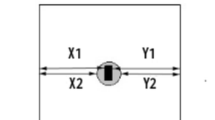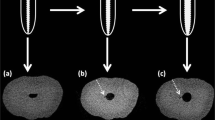Abstract
Objectives
To evaluate the shaping ability and cleaning after oval root canal preparation using one or more instruments in reciprocating or rotary motion.
Materials and methods
Oval-shaped mandibular incisors were selected, based on the radiographic diameter (2 ≤ diameter ratio ≤ 4), and assigned according to root canal preparation (n = 18): single-file (Reciproc R40); two reciprocating files (Unicone size 20 and 40, .06 taper) or Mtwo rotary files until a size 40, .06 taper instrument. Root canal preparations were performed using an open root canal model. Scanning was performed before and after preparation using SkyScan 1176 with a voxel size of 17.42 μm. Volume, percentage of debris, and percentage of uninstrumented surface were analyzed in the entire root canal and in each root canal third. Data were compared using ANOVA and Tukey or Kruskal-Wallis and Dunn tests (α = 5%).
Results
The initial volume were similar among the groups (p > .05). Unicone preparation was associated with higher debris, increase in root canal volume and uninstrumented surface in entire root canal and in the middle third (P < .05). Mtwo was associated with lower uninstrumented surface in the entire root canal and in the cervical third. The apical third were similar for the three preparations.
Conclusions
Unicone system using two instruments in reciprocating motion resulted in higher increase in volume. However, less remaining debris was observed when Reciproc single-file and Mtwo rotary systems were used.
Clinical relevance
A preparation that volumetrically increases the root canal is not necessarily associated with better cleaning. Shaping and hard-tissue debris removal depends on root canal anatomy, kinematics, number of instruments, and instrument design.

Similar content being viewed by others
References
Peters OA (2009) Current challenges and concepts in the preparation of root canal systems: a review. J Endod 30:559–567
De-Deus G, Barino B, Zamolyi R et al (2010) Suboptimal debridement quality produced by the single-file F2 Protaper technique in oval-shaped canals. J Endod 36:1897–1900. https://doi.org/10.1016/j.joen.2010.08.009
Versiani MA, Leoni GB, Steier L, de-Deus G, Tassani S, Pécora JD, de Sousa-Neto MD (2013) Micro-computed tomography study of oval-shaped canals prepared with the self-adjusting file, Reciproc, WaveOne, and ProTaper universal systems. J Endod 39:1060–1066. https://doi.org/10.1016/j.joen.2013.04.009
Farmakis ET, Sotiropoulos GG, Abràmovitz I, Solomonov M (2016) Apical debris extrusion associated with oval shaped canals: a comparative study of WaveOne vs Self-Adjusting File. Clin Oral Investig 20:2131–2138. https://doi.org/10.1007/s00784-016-1709-3
Vandenberghe B, Bud M, Sutanto A, Jacobs R (2010) The use of high-resolution digital imaging technology for small diameter K-file length determination in endodontics. Clin Oral Investig 14:223–231. https://doi.org/10.1007/s00784-009-0285-1
Robinson JP, Lumley PJ, Cooper PR, Grover LM, Walmsley AD (2013) Reciprocating root canal technique induces greater debris accumulation than a continuous rotary technique as assessed by 3-dimensional micro-computed tomography. J Endod 39:1067–1070. https://doi.org/10.1016/j.joen.2013.04.003
Espir CG, Nascimento-Mendes CA, Guerreiro-Tanomaru JM, Freire LG, Gavini G, Tanomaru-Filho M (2017) Counterclockwise or clockwise reciprocating motion for oval root canal preparation: a micro-CT analysis. Int Endod J. https://doi.org/10.1111/iej.12776
Pedullà E, Grande NM, Plotino G, Gambarini G, Rapisarda E (2013) Influence of continuous or reciprocating motion on cyclic fatigue resistance of 4 different nickel-titanium rotary instruments. J Endod 39:258–261. https://doi.org/10.1016/j.joen.2012.10.025
Amoroso-Silva P, Alcalde MP, Duarte MA et al (2016) Effect of finishing instrumentation using niti hand files on volume, surface area and uninstrumented surfaces in C-shaped root canal systems. Int Endod J 50:604–611. https://doi.org/10.1111/iej.12660
Metzger Z, Zary R, Cohen R, Teperovich E, Paqué F (2010) The quality of root canal preparation and root canal obturation in canals treated with rotary versus self-adjusting files: a threedimensional micro-computed tomographic study. J Endod 36:1569–1573. https://doi.org/10.1016/j.joen.2010.06.003
Moura-Netto C, Palo RM, Pinto LF, Mello-Moura AC, Daltoé G (2015) Wilhelmsen NS (2015) CT study of the performance of reciprocating and oscillatory motions in flattened root canal areas. Braz Oral Res 29:1–6. https://doi.org/10.1590/1807-3107BOR-2015.vol29.0006
Wu MK, R’Oris A, Barkis D, Wesselink PR (2000) Prevalence and extent of long oval canals in the apical third. Oral Surg Oral Med Oral Pathol Oral Radiol Endod 89:739–743. https://doi.org/10.1067/moe.2000.106344
Jou YT, Karabucak B, Levin J, Liu D (2004) Endodontic working width: current concepts and techniques. Dent Clin N Am 48:323–335. https://doi.org/10.1016/j.cden.2003.12.006
Versiani MA, Pécora JD, de Sousa-Neto MD (2011) Flat-oval root canal preparation with self-adjusting file instrument: a micro-computed tomography study. J Endod 37:1002–1007. https://doi.org/10.1016/j.joen.2011.03.017
Siqueira JF Jr, Alves FR, Almeida BM, de Oliveira JC, Rôças IN (2010) Ability of chemomechanical preparation with either rotary instruments or self-adjusting file to disinfect oval-shaped root canals. J Endod 36:1860–1865. https://doi.org/10.1016/j.joen.2010.08.001
Alves FR, Almeida BM, Neves MA, Moreno JO, Rôças IN, Siqueira JF Jr (2011) Disinfecting oval-shaped root canals: effectiveness of different supplementary approaches. J Endod 37:496–501. https://doi.org/10.1016/j.joen.2010.12.008
De-Deus G, Belladonna FG, Silva EJ et al (2015) Micro-CT evaluation of non-instrumented canal areas with different enlargements performed by NiTi systems. Braz Dent J 26:624–629. https://doi.org/10.1590/0103-6440201300116
Zuolo ML, Zaia AA, Belladonna FG, Silva EJNL, Souza EM, Versiani MA, Lopes RT, de-Deus G (2017) Micro-CT assessment of the shaping ability of four root canal instrumentation systems in oval-shaped canals. Int Endod J. https://doi.org/10.1111/iej.12810
Alcalde MP, Tanomaru-Filho M, Bramante CM, Duarte MAH, Guerreiro-Tanomaru JM, Camilo-Pinto J, Só MVR, Vivan RR (2017) Cyclic and torsional fatigue resistance of reciprocating single files manufactured by different nickel-titanium alloys. J Endod 43:1186–1191. https://doi.org/10.1016/j.joen.2017.03.008
Silva EJ, Villarino LS, Vieira VT et al (2016) Bending resistance and cyclic fatigue life of Reciproc, Unicone, and WaveOne reciprocating instruments. J Endod 42:1789–1793. https://doi.org/10.1016/j.joen.2016.08.026
Busquim S, Cunha RS, Freire L, Gavini G, Machado ME, Santos M (2015) A micro-computed tomography evaluation of long-oval canal preparation using reciprocating or rotary systems. Int Endod J 48:1001–1006. https://doi.org/10.1111/iej.12398
Sant’Anna Júnior A, Cavenago BC, Ordinola-Zapata R, de-Deus G, Bramante CM, Duarte MAH (2014) The effect of larger apical preparations in the danger zone of lower molars prepared using the Mtwo and Reciproc systems. J Endod 40:1855–1859. https://doi.org/10.1016/j.joen.2014.06.020
Freire LG, Iglecias EF, Cunha RS, Dos Santos M, Gavini G (2015) Micro-computed tomographic evaluation of hard tissue debris removal after different irrigation methods and its influence on the filling of curved canals. J Endod 41:1660–1666. https://doi.org/10.1016/j.joen.2015.05.001
da Silva Limoeiro AG, Dos Santos AH, De Martin AS et al (2016) Micro-computed tomographic evaluation of 2 nickel-titanium instrument systems in shaping root canals. J Endod 42:496–499. https://doi.org/10.1016/j.joen.2015.12.007
Paqué F, Laib A, Gautschi H, Zehnder M (2009) Hard-tissue debris accumulation analysis by high-resolution computed tomography scans. J Endod 35:1044–1047. https://doi.org/10.1016/j.joen.2009.04.026
Oliveira MA, Alves LD, Pereira AG, Raposo LH, Biffi JC (2015) Influence of flexion angle of files on the decentralization of oval canals during instrumentation. Braz Oral Res. 29:1–6. https://doi.org/10.1590/1807-3107BOR-2015.vol29.0078
Coelho BS, Amaral RO, Leonardi DP et al (2016) Performance of three single instrument systems in the preparation of long oval canals. Braz Dent J 27:217–222. https://doi.org/10.1590/0103-6440201302449
Çapar İD, Uysal B, Ok E, Arslan H (2015) Effect of the size of the apical enlargement with rotary instruments, single-cone filling, post space preparation with drills, fiber post removal, and root canal filling removal on apical crack initiation and propagation. J Endod 41:253–256. https://doi.org/10.1016/j.joen.2014.10.012
Siqueira JF Jr, Lima KC, Magalhães FA, Lopes HP, de Uzeda M (1999) Mechanical reduction of the bacterial population in the root canal by three instrumentation techniques. J Endod 25:332–333. https://doi.org/10.1016/S0099-2399(06)81166-0
Mickel AK, Chogle S, Liddle J, Huffaker K, Jones JJ (2007) The role of apical size determination and enlargement in the reduction of intracanal bacteria. J Endod 33:21–23. https://doi.org/10.1016/j.joen.2006.08.004
Rollison S, Barnett F, Stevens RH (2002) Efficacy of bacterial removal from instrumented root canals in vitro related to instrumentation technique and size. Oral Surg Oral Med Oral Pathol Oral Radiol Endod 94:366–371. https://doi.org/10.1067/moe.2002.126164
Saini HR, Tewari S, Sangwan P, Duhan J, Gupta A (2012) Effect of different apical preparation sizes on outcome of primary endodontic treatment: a randomized controlled trial. J Endod 38:1309–1315. https://doi.org/10.1016/j.joen.2012.06.024
Milanezi de Almeida M, Bernardineli N, Ordinola-Zapata R, Villas-Boas MH, Amoroso-Silva PA, Brandao CG, Guimaraes BM, Moraes IG, Hungaro-Duarte MA (2013) Micro–computed tomography analysis of the root canal anatomy and prevalence of oval canals in mandibular incisors. J Endod 19:1529–1533. https://doi.org/10.1016/j.joen.2013.08.033
Leoni GB, Versiani MA, Pécora JD, Sousa-Neto MD (2014) Micro–computed tomographic analysis of the root canal morphology of mandibular incisors. J Endod 40:710–716. https://doi.org/10.1016/j.joen.2013.09.003
Sampaio FC, Brito AP, Veloso HH, de Alencar AH, Decurcio DA, de Figueiredo JA, Estrela C (2017) Flute and shank dimensions of reciprocating instruments before and after simulated root canal shaping. J Contemp Dent Pract 18:198–204
Dietrich MA, Kirkpatrick TC, Yaccino JM (2012) In vitro canal and isthmus debris removal of the self-adjusting file, K3, and WaveOne files in the mesial root of human mandibular molars. J Endod 38:1140–1144. https://doi.org/10.1016/j.joen.2012.05.007
Pedullà E, Plotino G, Grande NM, Avarotti G, Gambarini G, Rapisarda E, Mannocci F (2016) Shaping ability of two nickel-titanium instruments activated by continuous rotation or adaptive motion: a micro-computed tomography study. Clin Oral Investig 20:2227–2233. https://doi.org/10.1007/s00784-016-1732-4
Hulsmann M, Peters OA, Dummer PMH (2005) Mechanical preparation of root canals: shaping goals, techniques and means. Endod Top 10:30–76
Funding
This study was funded by São Paulo Research Foundation—FAPESP 2015/03437-6.
Author information
Authors and Affiliations
Corresponding author
Ethics declarations
Conflict of interest
The authors declare that they have no conflict of interest.
Ethical approval
This article does not contain any studies with human participants or animals performed by any of the authors. All applicable international, national, and/or institutional guidelines for the care and use of animals were followed. All procedures performed in studies involving human participants were in accordance with the ethical standards of the institutional and/or national research committee and with the 1964 Helsinki declaration and its later amendments or comparable ethical standards.
Informed consent
For this type of study, formal consent is not required. Informed consent was obtained from all individual participants included in the study.
Rights and permissions
About this article
Cite this article
Espir, C.G., Nascimento-Mendes, C.A., Guerreiro-Tanomaru, J.M. et al. Shaping ability of rotary or reciprocating systems for oval root canal preparation: a micro-computed tomography study. Clin Oral Invest 22, 3189–3194 (2018). https://doi.org/10.1007/s00784-018-2411-4
Received:
Accepted:
Published:
Issue Date:
DOI: https://doi.org/10.1007/s00784-018-2411-4




